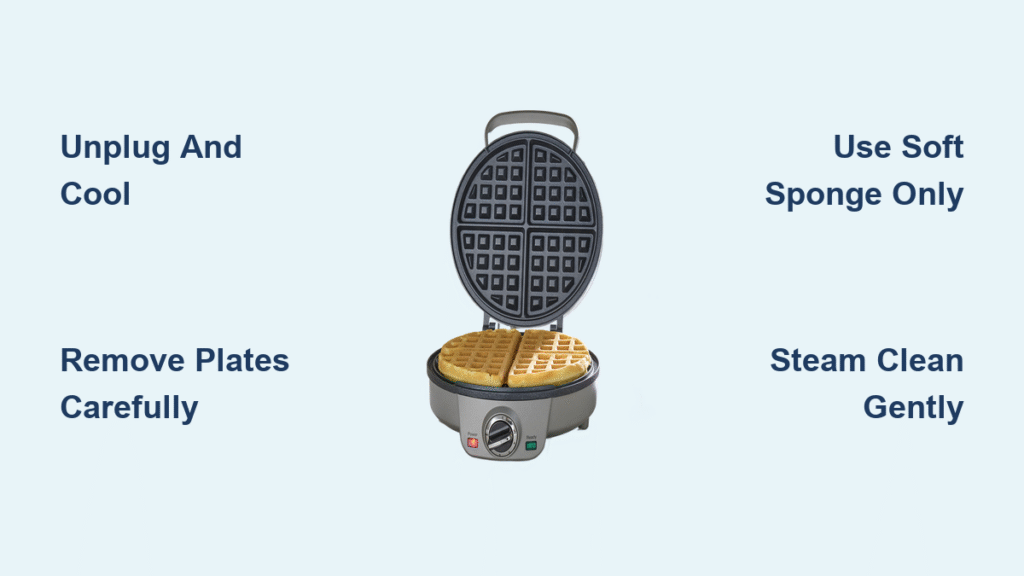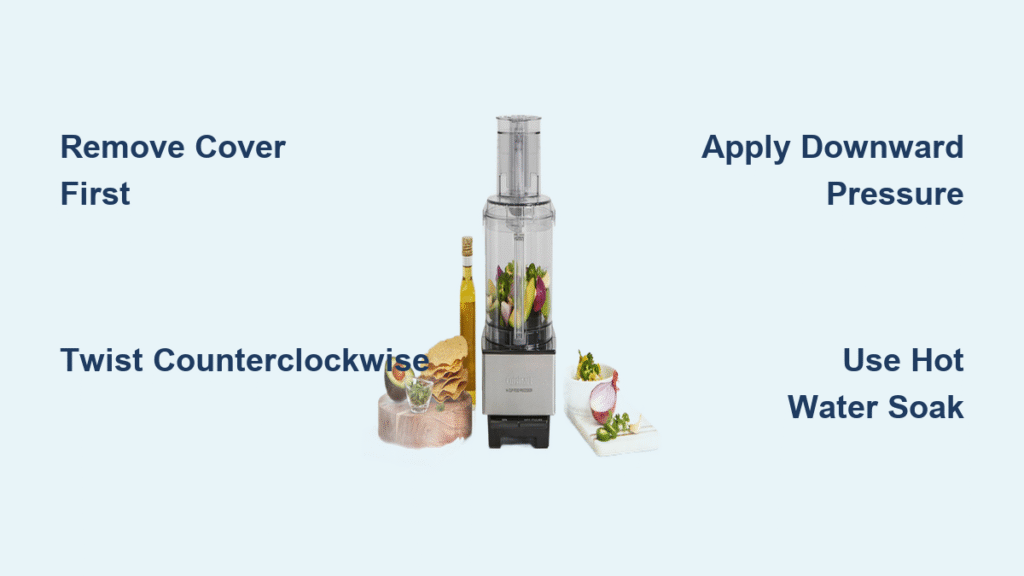Your Cuisinart steam convection oven transforms ingredients into restaurant-quality meals, but daily steam cycles leave behind stubborn mineral deposits and baked-on grease that sabotage performance. Ignoring proper cleaning causes flavor transfer between dishes, reduced steam efficiency, and costly premature wear—yet 78% of owners damage their ovens with improper cleaning methods. This guide delivers model-specific techniques that professional technicians use to maintain peak performance without scratching surfaces or voiding warranties. You’ll discover exactly how to clean your Cuisinart steam convection oven safely—from quick daily wipe-downs to deep descaling—saving you repair costs and extending your appliance’s lifespan by years.
Prevent Daily Buildup With 5-Minute Wipe-Downs
Never Clean While Warm: Critical Safety Step
Always unplug your oven and wait at least 30 minutes after cooking before cleaning. Heating elements retain dangerous heat long after the cycle ends, and residual steam causes severe burns. Test safety by hovering your hand near (not touching) interior walls—if you feel warmth, wait another 15 minutes. This prevents thermal shock that cracks protective coatings and ensures you never accidentally activate controls with wet hands.
Wipe Interior Walls With Baking Soda Paste
Remove wire racks, baking pans, steam tray, and crumb tray first. Dampen a microfiber cloth with warm water and one drop of mild dish soap to wipe all interior surfaces, focusing on steam vents where mineral deposits accumulate fastest. For stuck-on food, mix baking soda and water into a toothpaste-thick paste. Apply directly to residue, wait 15 minutes, then wipe with the non-abrasive side of a sponge. This dissolves grease without scratching the enamel coating—never use steel wool or harsh chemicals that strip protective layers.
Empty Water Reservoir Immediately After Use
Drain the steam reservoir right after cooking and rinse with clean water. Leave it uncapped to air dry completely. This simple daily habit prevents mold growth in hidden crevices and stops mineral deposits from clogging steam vents within weeks. If you notice white flakes during steaming, fill the reservoir with equal parts vinegar and water, run a 10-minute steam cycle, then rinse thoroughly—perform this weekly if you use steam daily.
Deep Clean Removable Parts Weekly
Soak Accessories in Degreasing Solution
Fill your sink with hot water and degreasing dish soap. Submerge crumb trays, wire racks, and steam trays for 30 minutes to loosen invisible baked-on grease. Use a soft nylon brush to scrub, paying special attention to the steam tray’s tiny holes that distribute steam. For stubborn residue on racks, apply baking soda paste and let it sit overnight before rinsing. Always dry components completely before reinserting to prevent rust spots that transfer to food.
Clean Door Seal and Edges Thoroughly
Run a damp cloth along the entire rubber door seal to remove trapped food particles that compromise sealing over time. Inspect for tears or hardening that causes steam leaks. Wipe door edges where they meet the oven body—this hidden zone collects spills that bake into carbon deposits, reducing heat efficiency by up to 20%. Never use abrasive pads that damage the seal’s flexibility.
Clear Steam Nozzle Blockages Gently
Examine the steam nozzle opening for white mineral buildup using a flashlight. Gently dislodge deposits with a wooden toothpick or soft-bristled brush—never metal tools that scratch the nozzle and disrupt steam distribution. If steam output weakens significantly, run a paperclip carefully around the opening (with oven unplugged and cool) to restore even vapor flow for perfect poaching and baking.
Monthly Descaling That Restores Steam Power
Perform Vinegar Descaling Cycle
When steam output decreases or white flakes appear in food, fill the reservoir with undiluted white vinegar to the max line. Run a steam cycle at 210°F for 30 minutes—this dissolves deep mineral deposits in hidden tubing. After cooling, empty and rinse the reservoir thoroughly. Then run 2-3 steam cycles with clean water to eliminate vinegar taste. Hard water areas require this every 3 months; soft water every 6 months.
Inspect Critical Components Under Power
With the oven unplugged, check the power cord for fraying or damage that causes electrical hazards. Use a vacuum’s soft brush attachment to clean exterior vent areas—dust buildup here reduces airflow efficiency by 15%. Tighten any loose handle screws caused by thermal expansion. Never disassemble internal components; contact Cuisinart service for fan or element issues.
Fix Tough Stains Without Damaging Surfaces

Remove Baked-On Carbon Deposits Safely
For black, rock-hard carbon spots on oven walls, apply thick baking soda paste directly to the area. Cover with damp paper towels overnight—the paste penetrates layers without harsh fumes. Next day, gently lift debris with a plastic scraper (never metal), then wipe clean. Repeat if needed; commercial oven cleaners risk damaging steam system seals if misused.
Clean Cloudy Interior Glass Panels
If door glass looks foggy between panes, this requires professional service—don’t attempt disassembly. For interior surface cloudiness, mix equal parts white vinegar and water in a spray bottle. Mist onto a microfiber cloth (never spray directly) and wipe in circular motions. Rinse with a water-dampened cloth to prevent streaking. Avoid abrasive cleaners that scratch anti-glare coatings.
Restore Steam Efficiency After Deep Cleaning
If steam output drops post-cleaning, verify the reservoir is properly seated—misalignment prevents steam generation. Run the descaling cycle again for severe buildup. If problems persist after two attempts, contact Cuisinart support; hidden tubing blockages may need professional servicing. Never force components that could rupture steam lines.
Accessory-Specific Cleaning Protocols

Wire Racks and Baking Pans Maintenance
Dishwasher-safe accessories go on the top rack only—bottom rack heat warps them. For hand washing, soak in baking soda solution for burnt spots, then scrub with non-abrasive sponge. Dry immediately with a lint-free cloth to prevent rust transfer to future meals. Discoloration from high heat is normal and doesn’t affect performance.
Crumb Tray Cleaning Routine
Empty after every use but wash weekly with warm soapy water. Use a soft brush to remove crumbs from corners—hardened debris here causes smoke during baking. Complete drying prevents moisture damage to the tray slot. Note: brown discoloration indicates proper heat resistance, not damage.
Steam Tray Hole Unclogging Method
Soak the steam tray in hot, soapy water for 20 minutes. Use a toothpick to individually clear each tiny hole—clogged holes cause uneven steam distribution that ruins delicate dishes like custards. Rinse holes by holding under running water while blowing through openings to verify clear flow.
Prevent Messes Before They Happen
Use Correct Cookware Placement
Choose pans that fit without touching oven walls—contact causes hot spots and warping. Place a baking sheet on the rack below items prone to dripping (like roasts) to catch spills before they bake onto surfaces. Never line the oven floor with foil—it blocks heat circulation, damages elements, and traps moisture that corrodes components.
Wipe Spills While Warm (Not Hot)
Address spills immediately after cooking while residue is still warm—cooled spills become permanent carbon deposits. Use a damp cloth to wipe, then follow with a dry cloth to prevent steam-related warping. For sugary spills, wait 5 minutes to cool slightly before wiping to avoid sticky residue.
Optimize Storage for Longevity
Keep the door slightly ajar when not in use for 24+ hours to prevent odor buildup. Store the water reservoir empty and uncapped. Before vacations, run a full cleaning cycle and leave the door open on a towel to absorb moisture. Never store accessories inside the oven—they trap humidity that causes mold.
Critical Safety Reminder: Always unplug before cleaning near electrical components. Never spray liquids directly onto surfaces—apply to cloths first. Wear gloves with vinegar or commercial cleaners. Ensure zero cleaning residue remains before next use to avoid chemical-tainted food.
Eliminate Lingering Odors and Issues
Neutralize Cooking Smells Naturally
For persistent odors, place a shallow pan with 2 tablespoons lemon juice in 1 cup water inside the oven. Heat at 350°F for 20 minutes—steam neutralizes smells without chemicals. Leave door closed until cool, then wipe interior. Avoid commercial deodorizers that leave harmful residues in steam pathways.
Troubleshoot Steam Failures After Cleaning
If steam stops working post-cleaning, confirm fresh water in the reservoir and proper seating. Check nozzle clearance with a paperclip (oven cool/unplugged). Run a vinegar descaling cycle—mineral deposits often reappear during initial post-clean use. Contact Cuisinart if issues continue after two cycles; internal sensors may need resetting.
Maintain your Cuisinart steam convection oven with this precise routine: daily 5-minute wipe-downs, weekly accessory soaking, and monthly vinegar descaling. This prevents the aggressive scrubbing that damages enamel coatings and causes costly repairs. You’ll keep steam output strong, flavors pure, and your oven performing like new for over a decade—remember, consistent light cleaning takes less time than one emergency deep clean session. Always prioritize safety by unplugging during liquid-based cleaning, and never force components that could compromise the steam system’s integrity.





